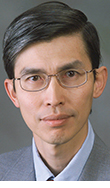Children create STEM-related projects in NSF-funded study

Francis Quek
Plastic cup robots that walk on Popsicle sticks were among numerous innovative science projects demonstrated by third- fourth- and fifth-grade student-scientists at a Jan. 14, 2016 showcase orchestrated by Francis Quek, professor of [visualization] (http://viz.arch.tamu.edu) at Texas A&M and a research team in a study aimed at finding ways to increase the involvement of children from underrepresented populations such as Latinos and African-Americans in science, technology, engineering and math, or STEM, fields.
The audience at Neal Elementary School in Bryan, including the students’ families, Bryan ISD administrators, educators, and [local media] (http://www.theeagle.com/news/local/educators-look-to-spur-students-interest-in-stem-programs/article_0f9385bf-f461-54b5-8f2a-aec7250452ac.html#user-comment-area) , watched as approximately 30 students from six classes demonstrated an array of devices — light projectors, chemical mixers, small heaters and more — all created with basic arts-and-crafts and electronics materials and powered by simple household batteries.
Patterned around the “ [maker movement] (http://time.com/104210/maker-faire-maker-movement/) ,” Quek said the three-year, $1 million National Science Foundation study engages children in hands-on exploration and invention to spark interest in scientific discovery.
“We’re researching approaches through which students may think of themselves as being interested in and capable of doing science,” he said. “Such identity development may have a greater impact over time than learning any one piece of science in elementary school. If the children think of themselves as capable of and interested in science and technology, they may persist in learning STEM subjects as they continue in school,” said Quek.
Engaging in creative, technology-related activities may also connect participating students to the larger STEM community, “creating a sense of belonging in that community, and,” he said, “helping prepare them to more easily assimilate in a rapidly changing technological world.”
The student projects showcased at the Jan. 14 event were selected from 28 individual class projects initiated last fall at Neal Elementary by Quek and his interdisciplinary team of Texas A&M faculty and graduate students.
The students’ involvement in the study is much more than a new learning experience, said Juanita Collins, the school’s principal. “They’ve become researchers at 8, 9 and 10 years old, and they’re gaining confidence and presentation skills while learning about the scientific method and leadership.”
The faculty team directing the project includes Sharon Lynn Chu, assistant professor of visualization, Patricia Larke and Lynn Burlbaw from the Department of Teaching, Learning and Culture, and Rebecca Schlegel, associate professor of psychology.
The collaboration between the Texas A&M research team and students at Neal will continue for two more years, as will the public demonstrations of the students’ innovative projects.
Tags
- diversity
- events
- feature
- interdisciplinary
- outreach
- partnerships
- research
- research gallery
- visualization
- viz gallery
Related Posts

Study eyes how STEM activities influence kids

Viz prof-led institute to study best tech learning methods

Students visualize data, win prizes at Build Day contest

Initiative fusing arts, technology education gains momentum
NSF group melding art, science learning
Follow Us
Facebook Twitter Vimeo Youtube Flickr RSS
Recent Posts

Planning prof heads study of disaster housing aid

A message from the dean

Former student remembered as expert planner

Leading educator named new head of Architecture Dept.









_thumbnail_small.png)
